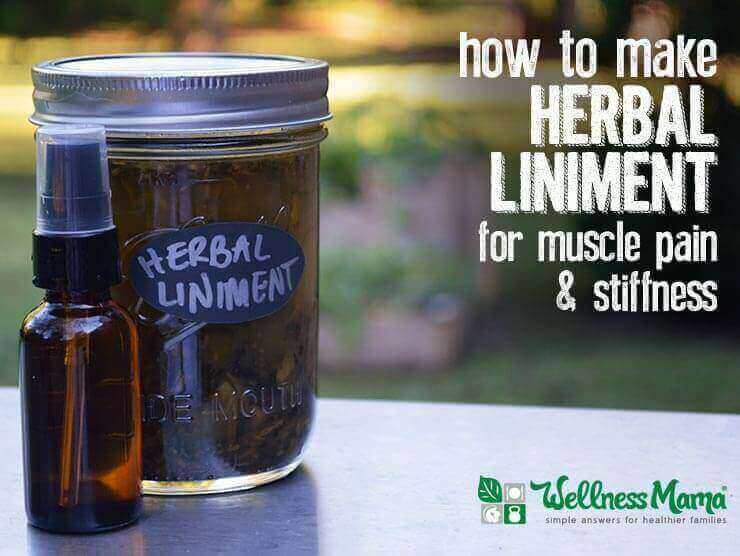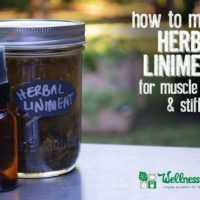If you were to visit my home and glance inside my pantry, you’d find the normal food stapes, but also several baskets and bins of assorted homemade herbal remedies in jars, tinctures in dropper bottles and salves in tins that we use for various ailments.
This herbal liniment is a mainstay in my home apothecary and we use it for sore muscles and other aches and pains (on un-broken skin!).
What is a Liniment?
A liniment is a topic remedy, either oil based or liquid, that helps relieve pain, stiffness and sore muscles.
Some liniments are oil based, but my preferred homemade liniment has an alcohol and witch hazel base with a concentration of herbs. Alcohol or witch hazel based liniments are highly effective because the alcohol is so quickly absorbed by the skin, carrying with it the beneficial properties of the added herbs.
Liniments can be made “warm” or “cool” by using different herbs. Using a mixture of cooling herbs (peppermint and menthol) and warming herbs (cayenne and ginger) can help create an alternating effect that I find more effective. I also like to add herbs that help speed recovery in other ways, like arnica, comfrey and yarrow, to speed healing even more.
Liniments have a long history of use on humans and on horses. In a sense, they are considered an “old-time” remedy, but they are still very effective and my go-to for muscle pain and soreness.
Why a Liniment?
I wish I’d had this remedy over a decade ago when I met my husband… We met on a walk across America one summer. We were with a group of college students and as a group we walked over 60+ miles a day, averaging about 15 miles per day individually. I’d “prepared” for the walk by running or jogging a couple of miles a day and buying new running shoes. Both big mistakes.
Mistake #1- New shoes + 15 miles a day = Blisters. Lots of blisters.
Mistake #2- Jogging uses completely different movement than walking and I felt my mistake for most of the first week of walking. In fact, the first couple of days, I was so sore, I didn’t know how I’d keep walking.
How I wish I’d had this homemade herbal liniment those first few weeks. The drug-store liniment we had didn’t do much for my sore muscles and it took a full week before my body got used to the walking so I wasn’t sore each day.
I’ve used this herbal liniment many times since I first made it several years ago, and it is by far the most effective topical remedy I’ve found for sore muscles. The beauty of a DIY liniment is that you can customize the strength and scent to meet your needs.
TIP: I’ve also found that alternating this with spray magnesium oil helps speed recovery even more.
Herbal Liniment Recipe
Materials
- 2 TBSP arnica flowers
- 2 TBSP comfrey flowers
- 2 TBSP lavender flowers
- 2 TBSP peppermint leaf
- 1 TBSP yarrow flowers
- 1 TBSP St. John’s Wort
- 1 tsp menthol crystals
- ½ tsp cayenne pepper
- 1 TBSP fresh ginger (finely chopped, optional)
- 1 cup witch hazel (or rubbing alcohol*)
Instructions
- Place all the herbs, menthol crystals, and fresh ginger if using in a pint size glass mason jar.
- Add the witch hazel or rubbing alcohol and make sure that all the herbs are covered.
- Let the mixture sit for at least 4 weeks (8 is preferable).
- Strain out the herbs and store the finished liniment in a spray bottle for easy use. If you don’t have a spray bottle, store in any glass bottle or jar and use a cotton ball or gauze pad for easy application. Use as needed for sore muscles.
Notes
A Simple Oil Based Alternative
I mentioned that I preferred an alcohol/witch hazel based liniment because I’ve found that they are more effective, but they do take several weeks to make correctly. If you don’t have the time, or would prefer not to order dried herbs, there is a simple and quick way to make an oil-based liniment that is almost as effective:
- Place 1/2 cup of carrier oil (almond, olive, coconut, etc) in a small jar. Add five drops of each of these essential oils (or any combination of these): Peppermint, Rosemary, Lavender, Eucalyptus, and Ginger.
This article was medically reviewed by Dr. Lauren Jefferis, board certified in Internal Medicine and Pediatrics. As always, this is not personal medical advice and we recommend that you talk with your doctor or work with a doctor at SteadyMD.
Have you ever used an herbal liniment? Did it work for you?



Leave a Reply